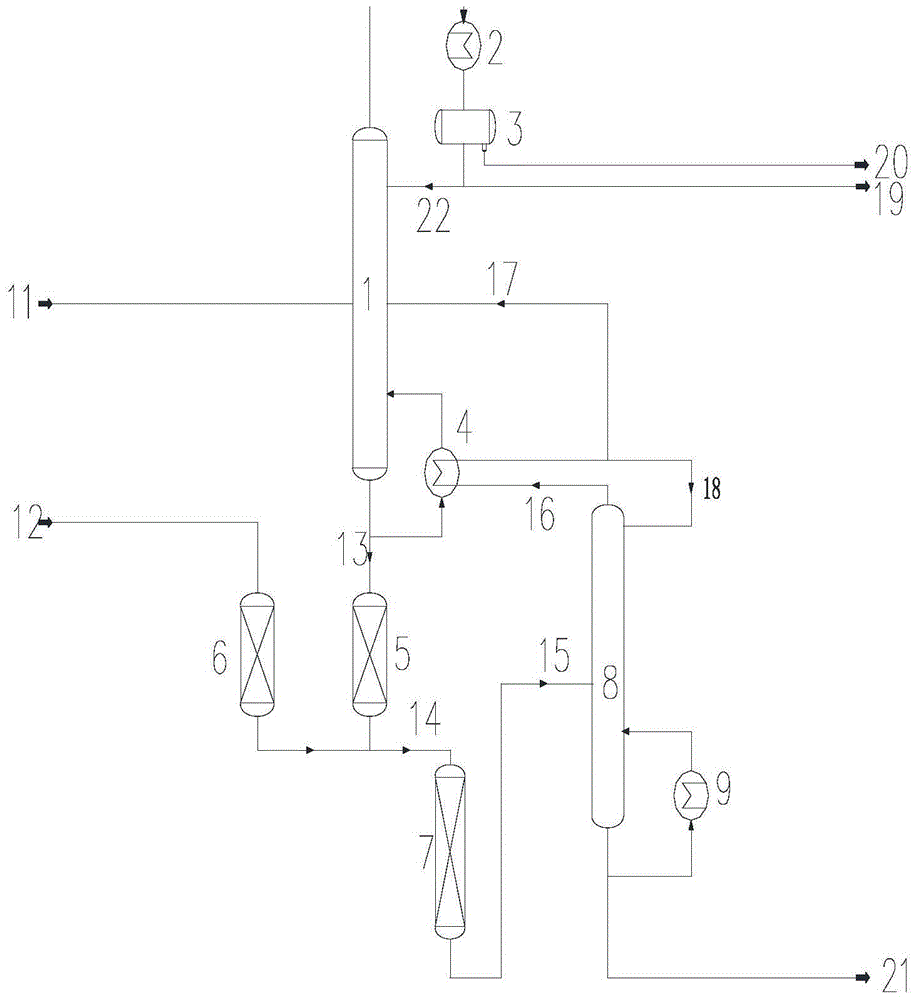A kind of C5/C6 alkane low-temperature isomerization method
A low-temperature isomerization and isomerization technology, which is applied in the field of light hydrocarbon isomerization, can solve the problems of increased coking tendency, lower isomerization rate of C5 hydrocarbons, lower isomerization rate, etc., to reduce heating and cooling energy consumption , Improve product octane number, improve the effect of isomerization rate
- Summary
- Abstract
- Description
- Claims
- Application Information
AI Technical Summary
Problems solved by technology
Method used
Image
Examples
Embodiment 1
[0031] A kind of C5 / C6 alkane low-temperature isomerization method, its technical process is as follows figure 1 shown. Using a commercially available low-temperature isomerization catalyst to carry out C5 / C6 alkane isomerization includes the following steps:
[0032] (1) The C5 / C6 raw material 11 (see Table 1 for properties) from the outside first enters the deisopentanizer 1, and the deisopentanizer 1 is provided with a top condenser 2 and a bottom reboiler 3 to remove Water is removed 20 and separated into an isopentane fraction 21 and a deisopentanizer fraction 13 . The isopentane fraction 19 goes to downstream processes. The removed water 20 is sent to the subsequent treatment device, and the top reflux 22 of the de-isopentanizer is refluxed into the de-isopentanizer 1 .
[0033] (2) The deisopentanized fraction 13 enters the deisopentanized fraction drier 5 for drying, and the moisture content of the dried deisopentanized fraction reaches the feeding condition of the ...
Embodiment 2
[0048] A method for isomerizing C5 / C6 alkane at low temperature, adopting the following steps:
[0049] 1) The raw material enters the deisopentanizer to remove moisture and is separated into isopentane fraction and deisopentane fraction, and the volume content of isopentane in the isolated isopentane fraction reaches more than 75%, and the isopentane fraction is removed Downstream process, remove water to follow-up treatment device;
[0050] 2) The deisopentanized fraction is dried in a drier, and the moisture content is controlled to be less than 1ppm;
[0051] 3) The external hydrogen enters the dryer to dry, and the moisture content is controlled to be less than 1ppm;
[0052] 4) The dried de-isopentanized fraction is mixed with hydrogen and then enters the isomerization reactor for isomerization reaction at low temperature. In this example, the reaction temperature is 150°C, and the isomerization reaction adopts Catalyst supported by γ-Al 2 o 3 , metal component Pt an...
Embodiment 3
[0055] 1) The raw material enters the deisopentanizer to remove moisture and is separated into isopentane fraction and deisopentane fraction, and the volume content of isopentane in the isolated isopentane fraction reaches more than 75%, and the isopentane fraction is removed Downstream process, remove water to follow-up treatment device;
[0056] 2) The deisopentanized fraction is dried in a drier, and the moisture content is controlled to be less than 1ppm;
[0057] 3) The external hydrogen enters the dryer to dry, and the moisture content is controlled to be less than 1ppm;
[0058] 4) The dried deisopentanized fraction is mixed with hydrogen and then enters the isomerization reactor to carry out the isomerization reaction at low temperature. In this example, the reaction temperature is 180° C., and the isomerization reaction adopts Catalyst supported by γ-Al 2 o 3 , metal component Pt and halogen Cl, wherein, the mass percentage of metal component Pt is 1.5%, the mass p...
PUM
 Login to View More
Login to View More Abstract
Description
Claims
Application Information
 Login to View More
Login to View More - R&D
- Intellectual Property
- Life Sciences
- Materials
- Tech Scout
- Unparalleled Data Quality
- Higher Quality Content
- 60% Fewer Hallucinations
Browse by: Latest US Patents, China's latest patents, Technical Efficacy Thesaurus, Application Domain, Technology Topic, Popular Technical Reports.
© 2025 PatSnap. All rights reserved.Legal|Privacy policy|Modern Slavery Act Transparency Statement|Sitemap|About US| Contact US: help@patsnap.com



